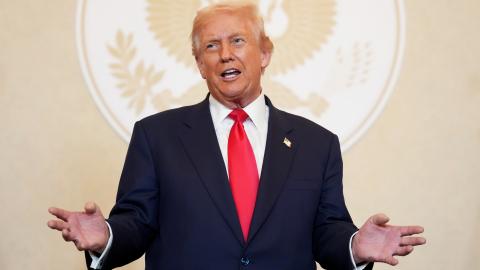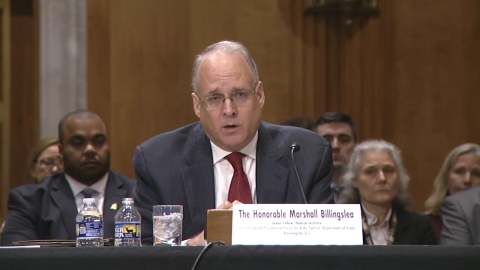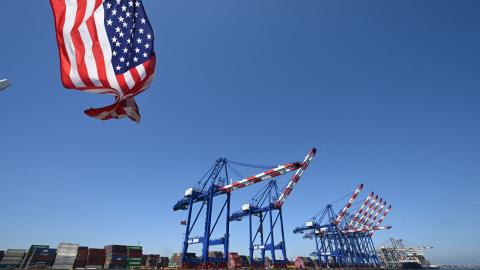After setbacks in another U.S. court and in the geopolitical rivalry with autocrats, President Donald Trump risks losing on his signature economic and foreign policy goals of rebalancing trade and recasting U.S. leadership in the global economic order. Although he is likely to lose his legal fight over his use of the International Emergency Economic Policy Act (IEEPA) to justify his trade program when the Supreme Court hears arguments this November, he has an opportunity to reinvigorate his plan if he acts decisively to win over traditional allies in creating a new trade order.
Putin’s clear rebuff of Trump’s Ukraine peace plans — and the continued embrace of the Russian dictator’s aggression by other revanchist autocrats in China, Iran, and North Korea — also offers Trump a second chance to engage more broadly with allies in Europe and the Pacific Rim to oppose Xi Jinping’s program of building an alternative economic and political order.
The decision on August 28 by the Court of Appeals for the Federal Circuit to affirm two lower-court decisions that struck down Trump’s use of IEEPA leaves little hope that the conservative Supreme Court will overturn the three lower-court rulings. The appeals court cited the lack of specific statutory authorities in IEEPA for imposing tariffs as well as a violation of the major-questions doctrine. The courts have generally deferred to the president for deciding when a national security threat exists, but the current situation has persisted for half a century and does not qualify as a sudden, short, and extreme economic challenge. Moreover, the administration’s sloppy and unrealistic claims of economic disaster, in its brief to the appellate court, are unlikely to sway a conservative court. Article I, Section 8 of the Constitution clearly grants all power to lay and collect tariffs to Congress. To avoid a constitutional confrontation, Trump will have to find new authority for his unilateral trade actions.
Xi’s highly orchestrated meeting of the Shanghai Cooperation Organization (SCO) over Labor Day demonstrated the will of authoritarian powers and their fellow travelers to resist Trump’s new assertiveness on trade and act collectively to build an alternative economic order. China’s display of solidarity with Russia and Iran was a clear rebuke to Trump’s peace efforts. Western allies fear not only a Russian takeover of Ukraine but also the renewal of Iran’s nuclear program and the ever-increasing bullying of China in the South China Sea and in the Taiwan Strait.
Western allies cannot have been overly impressed by the SCO’s economic offer of siding with China. This explicitly anti-Western grouping, with ten full members — including, notably, India and founding member Russia — and 14 “dialogue partners,” proudly claims that it represents 40 percent of the global population and around 25 percent of global GDP. China reports that its total trade with SCO members and partners reached $890 billion in 2024. Beijing also asserts that it is now the leader of the “rules-based” global order and used the 2025 Tianjin summit to invite other partners and observers to join its project to undermine the supposedly unreliable and weakening U.S.-led global order.
A cost-and-benefit calculus by other nations, however, would favor the U.S. and its allies. The U.S. alone represents 25 percent of global GDP. Together with its European and Pacific Rim allies, which include the wealthiest consumers in the world, this reaches more than 60 percent. Per capita income is six times higher in the U.S. than it is in China and seven times higher than it is in India. As far as trade reliability is concerned, the U.S. for 30 years has been the buyer of last resort for the subsidized overproduction of Chinese goods. Most countries, industrialized and developing alike, have felt the sting of Chinese mercantilism and intellectual-property theft. Even Europe, for many years a willing economic partner of China, now is ramping up tariff and other defensive instruments to counter Chinese dumping of subsidized products such as steel and electric vehicles.
Given the hard economic realities of Chinese mercantilism, the size and consumer orientation of the U.S. market, and the need to maintain the U.S. military umbrella in the face of the mutual support pact of authoritarian powers, traditional U.S. allies and other market-oriented countries should be open to a new U.S.-led global trade system. President Trump ought to seize the opportunity to deploy a course correction on trade and offer market-oriented democracies a path to work collectively on a new trade order. Most of these traditional allies have already signaled a willingness to accommodate Trump’s rebalancing efforts in some ways. Moreover, the head of the Council on Foreign Relations and former U.S. Trade Representative Michael Froman recently joined many others in declaring that “the global trading system as we have known it is dead.” U.S. Trade Representative Jamieson Greer has called for a new “Turnberry System” based on the U.S.-EU trade agreement reached at Trump’s Scottish resort in July.
The contours of a new system have already gained some broad support among experienced trade practitioners and scholars. The main features include a membership limited to market-oriented countries; national treatment but not most-favored-nation treatment; bilateral and regional agreements instead of a universal arrangement; limits on subsidization and a clear understanding that national security is an exception; a commitment to a rough balance of trade without currency manipulation or import restrictions, which could be a type of customs union; and openness to all countries that are willing to accept these new rules.
China would be excluded from the new system absent a major shift away from its mercantilism. The U.S. Congress would be expected to ratify the new system to cure the constitutional problem with IEEPA. Importantly, the U.S. should offer to grandfather the agreements with trading partners already signed in 2025 as the basis for those in the new system. And the U.S. should recommit to extending its security umbrella in Europe and Asia as an incentive for countries to join.
By promoting a new trade order with traditional and potential allies, Trump could achieve at least part of his goals of global rebalancing and international cooperation in the effort to blunt the authoritarian-led new economic order. Unilateral and punitive trade actions will only worsen the slowing U.S. economy, fragile bond market, persistent inflation, and growing irritation of many allies. Trump is already seeing weakening public support in opinion polls for his trade policy. In contrast, polls are indicating growing support, especially among Republicans, for taking more aggressive action against authoritarian aggression in Ukraine and elsewhere. A window is open for recalibrating his global programs, but the political and economic risks he faces will not disappear without course correction.















